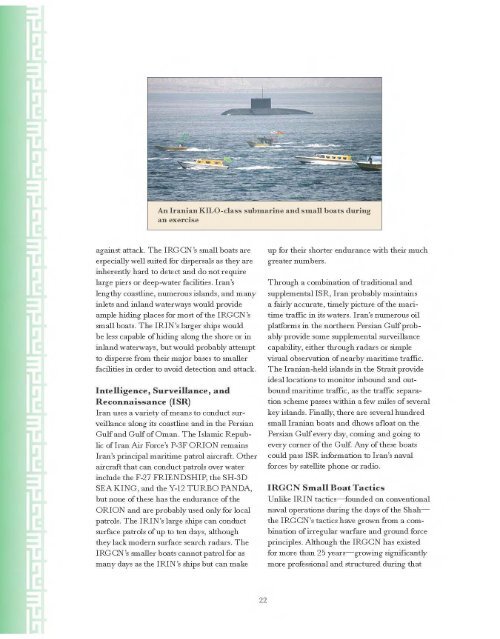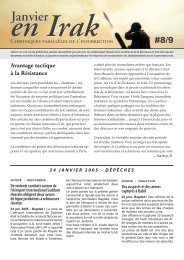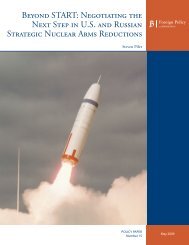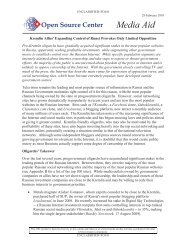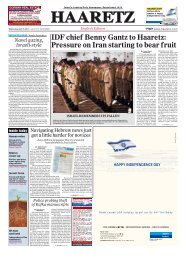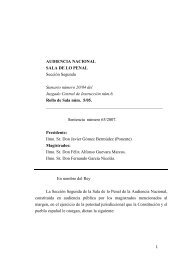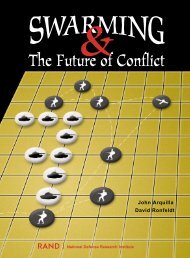Iran's Naval Forces: From Guerilla Warfare to a Modern Naval Strategy
Iran's Naval Forces: From Guerilla Warfare to a Modern Naval Strategy
Iran's Naval Forces: From Guerilla Warfare to a Modern Naval Strategy
You also want an ePaper? Increase the reach of your titles
YUMPU automatically turns print PDFs into web optimized ePapers that Google loves.
An Iranian KILO-class subIllarine and sIllall boats during<br />
an exercise<br />
against attack. The IRGCN's small boats are<br />
especially well suited for dispersals as they are<br />
inherently hard <strong>to</strong> detect and do not require<br />
large piers or deep-water facilities. <strong>Iran's</strong><br />
supplemental ISR, Iran probably maintains<br />
a fairly accurate, timely picture of the mari-<br />
time traffic in its waters. <strong>Iran's</strong> numerous oil<br />
platforms in the northern Persian Gulfprob-<br />
ably provide some supplemental surveillance<br />
capability, either through radars or simple<br />
lengthy coastline, numerous islands, and many<br />
inlets and inland waterways would provide<br />
ample hiding places for most of the IRGCN's<br />
small boats. The IRIN's larger ships would<br />
be less capable of hiding along the shore or in<br />
inland waterways, but would probably attempt<br />
<strong>to</strong> disperse from their major bases <strong>to</strong> smaller<br />
facilities in order <strong>to</strong> avoid detection and attack.<br />
Intelligence, Surveillance, and<br />
Reconnaissance (ISR)<br />
Iran uses a variety of means <strong>to</strong> conduct surveillance<br />
along its coastline and in the Persian<br />
Gulf and Gulf of Oman. The Islamic Republic<br />
ofIran Air Force's P-3F ORION remains<br />
<strong>Iran's</strong> principal maritime patrol aircraft. Other<br />
aircraft that can conduct patrols over water<br />
include the F-27 FRIENDSHIP, the SH-3D<br />
SEA KING, and the Y-12 TURBO PANDA,<br />
but none of these has the endurance of the<br />
ORION and are probably used only for local<br />
patrols. The IRIN's large ships can conduct<br />
surface patrols of up <strong>to</strong> ten days, although<br />
they lack modern surface search radars. The<br />
IRGCN's smaller boats cannot patrol for as<br />
many days as the IRIN's ships but can make<br />
up for their shorter endurance with their much<br />
greater numbers.<br />
Through a combination of traditional and<br />
visual observation of nearby maritime traffic.<br />
The Iranian -held islands in the Strait provide<br />
ideal locations <strong>to</strong> moni<strong>to</strong>r inbound and outbound<br />
maritime traffic, as the traffic separation<br />
scheme passes within a few miles of several<br />
key islands. Finally, there are several hundred<br />
small Iranian boats and dhows afloat on the<br />
Persian Gulf every day, coming and going <strong>to</strong><br />
every corner of the Gulf. Any ofthese boats<br />
could pass ISR information <strong>to</strong> <strong>Iran's</strong> naval<br />
forces by satellite phone or radio.<br />
IRGCN Stnall Boat Tactics<br />
Unlike IRIN tactics-founded on conventional<br />
naval operations during the days of the Shahthe<br />
IRGCN's tactics have grown from a combination<br />
of irregular warfare and ground force<br />
principles. Although the IRGCN has existed<br />
for more than 25 years-growing significantly<br />
more professional and structured during that<br />
22


